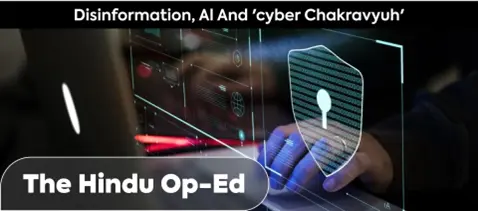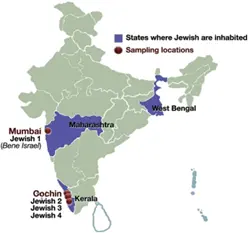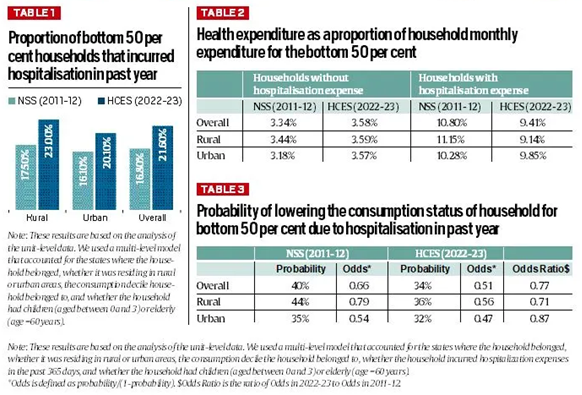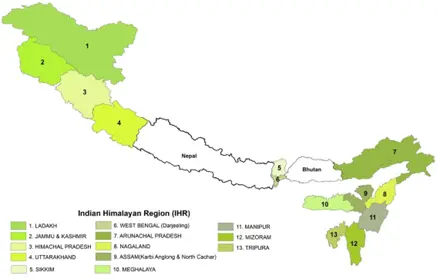Wednesday, 14th August 2024
Disinformation, AI and Cyber Chakravyuh
Why in the news?
- The year 2024 has seen a marked increase in global security threats, driven significantly by advancements in Artificial Intelligence (AI).
- The emergence of Generative AI and Artificial General Intelligence (AGI) has expanded the spectrum of threats, encompassing not only traditional cyberattacks but also sophisticated disinformation campaigns.

Dangers Posed by AI in 2024:
- Cybersecurity Concerns at the 2024 Summer Olympic Games:
- The 33rd Summer Olympic Games in France, held in July and August 2024, were identified as a prime target for digital criminals, particularly cyber attackers.
- Despite the Games concluding without major incidents, the underlying threat remains. Security agencies continue to maintain a heightened state of alert, reflecting the ongoing risks in this new digital age.
- Disinformation and AI-Generated Deep Fakes during Taiwanese Elections:
- January 2024 witnessed a surge in disinformation during the Taiwanese elections, fueled by AI-generated deep fakes.
- The resulting chaos was largely attributed to external influences, particularly China.
- The ease with which AI can disseminate false information has made it a powerful tool in undermining democratic processes.
The Evolution of Cyberattacks as National Security Threats:
- From Digital Mischief to National Security Threats:
- Cyberattacks have evolved from isolated digital mischief to significant threats capable of undermining national security.
- The integration of AI technologies has amplified these threats, enhancing their sophistication, scale, and impact, thereby blurring the distinction between state and non-state actors.
- Vulnerability of Critical Infrastructure:
- Critical infrastructure, including electricity, water supply, telecommunications, and transportation, is increasingly vulnerable to cyberattacks.
- Cyberattacks targeting these infrastructures can lead to widespread disruption, economic loss, and even physical harm.
- The conflict in Ukraine serves as a pertinent example of how cyber warfare can destabilise a nation and disrupt critical services.
- Economic Destabilisation and Broader Implications:
- The risk of economic destabilisation from cyberattacks is significant. Financial markets, supply chains, and key components of the global economy are highly vulnerable.
- A successful cyberattack on these systems could trigger a cascading effect, leading to economic downturns and regional instability, which could exacerbate existing conflicts.
- Undermining Public Trust in Government Institutions:
- In democracies, where legitimacy relies on public confidence, disruptions to elections or manipulations of public opinion through cyberattacks could have severe consequences, leading to political instability and social unrest.
Role of AI in Cyberattacks
- AI-Enabled Cyber Threats:
- AI has significantly complicated the cyber threat landscape by enabling more sophisticated and automated attacks.
- AI algorithms can scan networks, launch attacks, and adapt in real-time to countermeasures, making AI-powered cyberattacks particularly dangerous.
- AI also facilitates the creation of highly convincing disinformation campaigns, which can amplify the impact of cyberattacks by creating confusion and mistrust.
- Ethical and Legal Considerations:
- The use of AI in cyberattacks raises critical ethical and legal questions, including the potential for collateral damage, accountability of autonomous systems, and implications of AI-driven decision-making in warfare.
- Nations must balance the need for effective defence with the responsibility to uphold international norms and human rights.
Microsoft Outage: A Preview of Potential Cyber Disasters
- June 2024 Incident:
- In June 2024, a 'glitch' in a Microsoft Windows software update caused a massive global outage, affecting critical operations such as flight control and stock exchanges.
- While this incident was not a cyberattack, it highlighted the potential scale of disruption that could result from a genuine cyberattack, underscoring the vulnerability of global systems.
Way Forward:
- Comprehensive Cyber Defense Strategy:
- Nations must adopt a comprehensive and multi-layered cyber defence strategy, which includes the development of advanced technological solutions and the strengthening of international cooperation.
- Public-private partnerships are essential, as critical infrastructure is often privately owned and operated.
- Training, Education, and Awareness:
- Ongoing investment in cybersecurity training is crucial to develop a workforce capable of navigating the complexities of modern cyber threats.
- Public education on cybersecurity risks is also necessary to encourage responsible behaviour online and reduce the likelihood of successful attacks.
Conclusion
The digital threats of 2024 underscore the urgent need for coordinated action. Nations, particularly democracies, must counter digital surveillance, disinformation, and manipulation to ensure survival in an increasingly digital world. The lessons of 2024 emphasise the importance of remaining vigilant and prepared for the challenges that lie ahead.
|
UPSC Civil Services Examination PYQ Mains: Q:1 Discuss different types of cybercrimes and measures required to be taken to fight the menace. (2020) Q:2 “The emergence of the Fourth Industrial Revolution (Digital Revolution) has initiated e-Governance as an integral part of government”. Discuss. (2020) |
Source: TH
Australia, U.S., U.K. sign nuclear transfer deal for AUKUS
Why in the news?
- Australia has signed a landmark deal with the United States and the United Kingdom to exchange nuclear technology and materials, furthering its plan to equip its navy with nuclear-powered submarines as part of the 2021 AUKUS security pact.
- This agreement outlines secure arrangements for transferring sensitive nuclear materials and knowledge.

Key Highlights:
- AUKUS Partnership:
- Established: September 2021
- Members: Australia, the United Kingdom, and the United States
- Objective: To enhance trilateral security cooperation in the Indo-Pacific region
- First Major Initiative: Development and deployment of a nuclear-powered submarine fleet for Australia
- Note: The submarines will not be armed with nuclear weapons due to Australia's commitment to the Nuclear Non-Proliferation Treaty (NPT).
- Details of the Deal:
- Submarine Acquisition: The United States plans to sell Australia three Virginia-class nuclear-powered submarines in the early 2030s, with an option for two additional units.
- Future Submarines:
- The deal includes the development of the SSN-AUKUS, a new class of submarine based on Britain’s next-generation design, incorporating advanced U.S. technologies.
- These submarines will be built in both the U.K. and Australia.
Significance of the Deal:
- For the U.S.: This is the second instance of the U.S. sharing nuclear submarine technology, the first being with the U.K. in 1958.
- For the Indo-Pacific Region: The partnership aims to enhance regional security and cooperation but could potentially intensify the arms race, according to some analysts.
- For Australia: This deal marks Australia's entry into the elite group of nations operating nuclear-powered submarines. It will provide Australia with increased naval capabilities in the Pacific, countering China's growing influence. However, it may strain relations with Beijing.
- For India: The pact contributes to the broader effort to balance China's power in the region and strengthens the QUAD alliance, of which Australia and India are key members.
- For France: France has expressed dissatisfaction, viewing the deal as a betrayal. Australia had previously contracted with France for 12 Attack-class submarines, with the first expected to be operational around 2034. The new deal nullifies this contract.
- China’s Reaction:
- China has condemned the deal, arguing that such partnerships should not target other nations.
- It asserts that the deal undermines regional peace and stability, exacerbates the arms race, and undermines international non-proliferation efforts, accusing Western powers of using nuclear exports for geopolitical purposes.
Source: TH
PM Surya Ghar: Muft Bijli Yojana
Why in the news?
- Recently, the Scheme Guidelines for implementation of ‘Model Solar Village’ under PM-Surya Ghar, 1.28 crore registrations and 14.84 lakh applications fuel India’s solar energy expansion.

About the PM Surya Ghar:
- The PM Surya Ghar: Muft Bijli Yojana is a landmark initiative that was launched by Prime Minister Narendra Modi on February 15, 2024.
- It aims to transform India's energy landscape by providing free electricity to households.
- This ambitious scheme empowers households to harness solar energy by offering a substantial subsidy covering up to 40% of the cost of installing solar panels on their rooftops.
- By enabling widespread adoption of solar power, the scheme is poised to benefit 1 crore households across the country.
- Furthermore, it is projected to generate significant savings for the government, estimated at Rs. 75,000 crores annually in electricity costs.
Key Benefits:
- Free Electricity for Households: The scheme provides households with free electricity by installing subsidised rooftop solar panels, significantly reducing their energy costs.
- Reduced Electricity Costs for the Government: By promoting the widespread use of solar power, the scheme is expected to save the government an estimated ₹75,000 crore annually in electricity costs.
- Increased Use of Renewable Energy: The scheme encourages the adoption of renewable energy sources, contributing to a more sustainable and environmentally friendly energy mix in India.
- Reduced Carbon Emissions: The transition to solar energy under this scheme will help lower carbon emissions, supporting India's commitment to reducing its carbon footprint.
Subsidy:
- Subsidy Application and Vendor Selection:
- Households can apply for the subsidy through the National Portal.
- The portal also facilitates the selection of a suitable vendor for installing the rooftop solar system.
- The National Portal provides essential tools and information such as appropriate system sizes, a benefits calculator, vendor ratings, and other relevant details to assist households in making informed decisions.
- Collateral-Free Loans:
- Households will have access to collateral-free, low-interest loans at an approximate rate of 7% interest.
- These loans are available for the installation of residential rooftop solar (RTS) systems with capacities up to 3 kW.

Eligibility:

Impact:
- Household Savings and Income Generation:
- Households will benefit from significant savings on their electricity bills. Additionally, they will have the opportunity to earn extra income by selling surplus power generated by their rooftop solar systems to DISCOMs.
- For instance, an average 3-kW system can generate over 300 units per month, providing a reliable energy source and potential revenue.
- Expansion of Solar Capacity:
- The scheme is projected to add 30 GW of solar capacity through rooftop installations in the residential sector, significantly contributing to India's renewable energy goals.
- Environmental Benefits:
- Over the 25-year lifetime of these rooftop systems, it is estimated that the scheme will generate 1000 BUs of electricity while reducing CO2 emissions by 720 million tonnes, making a substantial positive impact on the environment.
- Job Creation:
- The scheme is also expected to create approximately 17 lakh direct jobs across various sectors, including manufacturing, logistics, supply chain, sales, installation, operations and maintenance (O&M).
Model Solar Village:
- Under the "Model Solar Village" component of the scheme, the focus is on establishing one Model Solar Village per district throughout India.
- This initiative aims to promote solar energy adoption and empower village communities to achieve energy self-reliance.
- An allocation of ₹800 crore has been designated for this component, with ₹1 crore provided to each selected Model Solar Village.
- To qualify as a candidate village, it must be a revenue village with a population of over 5,000 (or 2,000 in special category states).
- Villages are selected through a competitive process and evaluated on their overall distributed renewable energy (RE) capacity six months after being identified by the District Level Committee (DLC).
- The village in each district with the highest RE capacity will receive a central financial assistance grant of ₹1 crore.
- Under the supervision of the DLC, the State/UT Renewable Energy Development Agency will oversee the implementation, ensuring these model villages successfully transition to solar energy and set a benchmark for others across the country.
Conclusion
The "PM Surya Ghar: Muft Bijli Yojana" represents a transformative step in India's sustainable energy and economic empowerment journey. By providing substantial subsidies for rooftop solar installations, the scheme promises to significantly reduce household electricity costs. As India progresses with this ambitious initiative, it will undoubtedly set a precedent for solar energy adoption and inspire similar efforts globally.
Source: PIB
India has laws on the movement of ballast water
Why in the news?
- The Tamil Nadu Water Resources Department (WRD) has recently informed the National Green Tribunal about a request for ₹160 crore from Kamarajar Port in Ennore, Tamil Nadu, to address the removal of invasive charru mussels (Mytella strigata) along the coast.

- These invasive mussels are damaging marine ecosystems and obstructing fishing activities, thereby affecting local livelihoods.
- The WRD has accused Kamarajar Port of contributing to the spread of this invasive species due to inadequate regulation of ballast water from ships.
Invasive Species and Their Threat to Ecosystems
- Definition: Invasive species are non-native organisms introduced, either accidentally or intentionally, into a new environment where they do not naturally occur.
- Impact:
- These species can spread rapidly, causing significant harm to local ecosystems, economies, and human health.
- They often outcompete native species for resources, disrupt food webs, alter habitats, and can even lead to the extinction of native species.
- Human Activities: One of the primary ways invasive species are introduced is through human activities like global trade and transportation, particularly through the movement of ballast water in ships.
Case Study: Charru Mussels (Mytella strigata)
- Background: The charru mussel, native to South America, has become a significant ecological threat in regions like the coast near Kamarajar Port in Ennore, Tamil Nadu.
- Spread: The spread of this invasive species is largely attributed to ballast water discharge from ships, which has not been adequately regulated.
- Ecological and Economic Threats:
- The mussels reproduce quickly, forming dense colonies that outcompete native species for space and resources.
- They attach to various surfaces, including rocks, marine organisms, and man-made structures like boats and docks, leading to the displacement of native species and a reduction in biodiversity.
- In the Ennore region, dense colonies of charru mussels have hindered fishing activities, negatively impacting the livelihoods of local fishermen.
Ballast Water
- Purpose: To maintain this, sea water (known as ballast water) is taken into tanks onboard when cargo is offloaded, and the ship rises. Conversely, when cargo is loaded, the ballast water is pumped out.
- Risks: Ballast water often contains various marine organisms, which can be discharged in new locations, potentially introducing invasive species to these areas.

Laws Regulating the Movement of Ballast Water
- Background: Historically, there were no restrictions on the intake and discharge of ballast water, leading to the spread of invasive species across regions.
- Global Response:
- The Ballast Water Management (BWM) Convention was enforced by the International Maritime Organization (IMO) in 2017 to prevent the spread of harmful aquatic organisms and pathogens through ships' ballast water.
- Regulations:
- Ships must manage their ballast water to remove or neutralise organisms before discharge.
- Newly built ships are equipped with ballast water management systems that treat the water with chemicals to eliminate biological organisms.
- Older ships are required to exchange ballast water taken at ports with neutral ocean water during their journey.
- International Practices:
- Countries like Australia and New Zealand enforce these regulations strictly to protect their marine ecosystems.
- Australia conducts rigorous checks on ships, especially near sensitive areas like the Great Barrier Reef, to prevent ecological damage.
Situation in India:
- Current Status:
- As of July 2024, 97 countries have signed the BWM Convention, but India is not among them.
- Consequently, ships docking at Indian ports are not obligated to follow the BWM Convention, and ballast water remains largely unchecked, though other regulations such as those related to oil discharge are enforced.
Way Forward for India
- Need for Regulation:
- Maritime law experts highlight those ports, as facilitators, cannot be held liable unless a law is in place.
- If evidence shows that a vessel discharged ballast water leading to the spread of invasive species, the vessel owner could be held accountable if relevant laws are enforced.
- Joining the BWM Convention:
- India must consider joining the BWM Convention to address the current regulatory gap and protect its marine ecosystems from the threat of invasive species.
Source: TH
Jewish - A Dwindling Community in India
Why in the news?
- India's Jewish community, which once numbered between 20,000 to 50,000 during the mid-1940s, has now dwindled to an estimated 4,000–5,000 people.

History of the Jews in India:
- Origin:
- The first Jews in India are believed to have settled on the Malabar coast after the Assyrian conquest of the Kingdom of Israel in the 9th century B.C.E.
- Key Jewish communities in India include the Bene Israel, the Cochin Jews, and the Bnei Menashe.
- Under British Imperial Rule:
- The Jewish community in India thrived under British rule, achieving significant population growth and wealth. The Jewish population in British India peaked at around 20,000 - 50,000 by the mid-1940s.
- Jewish Emigration from India:
- The rise of Indian nationalism, coupled with the creation of the State of Israel in 1948, led many Jews to leave India.
- Despite significant emigration, the Jewish community remained active in India throughout the latter half of the 20th century.
- Jewish Community in India Today:
- India is home to three historically distinct Jewish communities: the Bene Israel, the Cochin Jews, and the Baghdadi Jews. The current Jewish population in India is estimated to be between 4,000 to 5,000.
- The majority of the remaining Jewish population in India belongs to the Marathi-speaking Bene Israel community, which has been settled on the Konkan coast for centuries.
- Kerala’s Jewish communities, particularly the Malabar/ Cochin Jews, hold the distinction of being the oldest Jewish communities in India.
The Jews of Kerala
- Malabar/ Cochin Jews:
- The oldest documentary evidence of this community is found in the copper plates of Cranganore’s Hindu ruler from circa 1,000 CE, which list various economic and ceremonial privileges enjoyed by the Jews.
- After the arrival of the Portuguese in the 16th century, many Malabar Jews relocated to Cochin (now Kochi) where they were welcomed by the local king.
- Paradesi/ Foreign Jews:
- These Jews migrated to India from the Iberian Peninsula in the 15th and 16th centuries, fleeing persecution by the Catholic rulers of Spain and Portugal.
- They settled alongside the pre-existing Jewish communities on the Malabar coast and in Madras (now Chennai). The Paradesi Jews were active in Kerala’s spice trade, while those in Madras engaged in the trade of Golconda diamonds and other precious stones.
- Cultural Evolution of Kerala Jews:
- The Paradesi Jews adopted Malayalam and many local customs, but they stopped marrying members of Kerala’s older Jewish community, leading to the formation of two distinct Jewish communities: the Paradesis (white Jews) and the Malabaris (black Jews).
Reasons for the Decline of the Jewish Community in India/Kerala:
- Lack of Persecution:
- Unlike Jewish communities in Europe or West Asia, Jews in India seldom faced anti-Semitism or persecution. Despite this, there has been a steady migration of Kerala Jews to Israel since the 1950s.
- Migration to Israel:
- The majority of Jews who emigrated from India did so out of a love for Israel and the influence of Zionism, rather than any disdain for India.
- Today, only 14 Malabar Jews and one Paradesi Jew remain in Kerala.
Source: IE
NIRF Ranking 2024
Why in the news?
- The Indian Institute of Technology (IIT) Madras has been ranked as the top educational institution in India for the sixth consecutive year according to the National Institutional Ranking Framework (NIRF) for 2024.

Background:
- Ranking higher education institutions in India poses challenges due to the country's vast diversity. To address this, the Ministry of Education introduced the National Institutional Ranking Framework (NIRF) in 2016.
- The NIRF establishes key performance indicators to evaluate institutions, offering a structured approach for assessing and comparing their effectiveness.
- Since its establishment, the NIRF has become a critical tool for institutions nationwide to gauge their performance and strive for improvement.
About the National Institutional Ranking Framework (NIRF):
- The NIRF is a methodology developed by the Ministry of Education to rank higher education institutions in India based on various parameters.
Key Features of the NIRF Rankings:
- Participation: Institutions voluntarily submit detailed data to the NIRF, which is then used to generate rankings based on the framework’s criteria.
- Transparency: The NIRF ensures transparency by making its ranking methodology, data sources, and scoring system publicly available. This transparency helps institutions understand areas for improvement.
- Impact: The rankings are a vital reference for students and parents when selecting educational institutions. They also incentivize institutions to enhance their performance in teaching, research, and inclusivity.
How NIRF Ranks Institutions:
- The NIRF provides rankings in multiple categories including ‘Overall,’ ‘Research Institutions,’ ‘Universities,’ ‘Colleges,’ and specific disciplines such as engineering, management, pharmacy, and law. Institutions are assessed based on five broad parameters:
- Teaching, Learning and Resources (TLR): 30% weightage
- Research and Professional Practice (RP): 30% weightage
- Graduation Outcomes (GO): 20% weightage
- Outreach and Inclusivity (OI): 10% weightage
- Perception (PR): 10% weightage
NIRF 2024 Rankings:
- IIT Madras has been ranked as the top educational institution in India for the sixth year running and continues to lead the engineering category for the ninth consecutive year.
- Indian Institute of Science (IISc), Bengaluru retains its top position in both the university and research categories.
- IIM Ahmedabad remains the leading management institute for the fifth year, and AIIMS Delhi is the top medical college for the seventh consecutive year.
- This year’s rankings, announced by Union Education Minister Dharmendra Pradhan, include 16 categories with new additions for open universities, skill universities, and State public universities.
- A total of 6,517 institutions participated in the rankings.
- IIT Delhi and IIT Bombay follow IIT Madras in the engineering category, while IIM Bangalore and IIM Kozhikode rank after IIM Ahmedabad in management.
- Hindu College and Miranda House lead the colleges category, and National Law School of India University, Bengaluru remains the top law institution for the seventh year.
- Anna University, Chennai is recognized as the best State public university, and IGNOU, New Delhi is the top open university.
- The Ministry of Education is considering the inclusion of institutions from neighbouring countries in future NIRF rankings.
Source: IE
Distributed Denial-of-Service (DDoS) Attack
Why in the news?
- Recently, tech billionaire Elon Musk has flagged a "massive DDOS attack" on X that disrupted the airing of his interview with former US President Donald Trump.

What is a DDoS Attack?
- A Distributed Denial-of-Service (DDoS) attack is a malicious attempt to disrupt the normal operation of a targeted server, service, or network by overwhelming it with an excessive amount of Internet traffic.
- This type of cyberattack is designed to prevent legitimate users from accessing online services and websites.
- Unlike other cyberattacks that aim to breach security systems, DDoS attacks focus on making the target's services unavailable.
Key Characteristics:
- Flooding Traffic: DDoS attacks work by flooding a target with a massive volume of traffic, exceeding the capacity of the server or network infrastructure.
- Compromised Devices: Attackers utilise networks of compromised computers and Internet-connected devices, known as botnets, to generate the attack traffic.
- No Breach Attempt: Instead of attempting to breach security defences, a DDoS attack aims to disrupt service availability.
- Potential Smokescreen: DDoS attacks can be used to distract from other malicious activities or to disable security systems.
How Does a DDoS Attack Work?
- Botnet Formation: Attackers first infect a network of computers and IoT devices with malware, creating a botnet of compromised devices.
- Attack Execution: The attacker sends instructions to the botnet to target the victim’s server or network.
- Traffic Overload: Each bot in the network sends requests to the target's IP address, causing the server or network to become overloaded.
- Denial of Service: The overwhelming volume of requests results in a denial of service, making it impossible for legitimate users to access the targeted service.
Source: NDTV
INS Arighat
Why in the news?
- INS Arighat is India's second nuclear-powered ballistic missile submarine (SSBN), representing a significant enhancement of the country's naval and strategic capabilities.
- It is designed to bolster India's nuclear deterrence by enabling sea-based nuclear missile launches.

Key Features:
- Commissioning: INS Arighat is set to be commissioned as the second SSBN in India’s fleet, following INS Arihant, which was commissioned in 2018.
- Construction: The submarine was built at the Indian Navy's Ship Building Centre (SBC) in Visakhapatnam, showcasing India's growing indigenous defence manufacturing capabilities.
Specifications:
- Dimensions:
- Length: 111.6 meters
- Beam: 11 meters
- Draught: 9.5 meters
- Displacement: 6,000 tonnes
- Propulsion: It is powered by a pressurised water reactor and features a seven-blade propeller.
- Speed:
- Surface Speed: 12–15 knots (22–28 km/h)
- Submerged Speed: 24 knots (44 km/h)
- Armament:
- Capable of carrying up to four K-4 SLBMs (Submarine Launched Ballistic Missiles) with a range exceeding 3,500 kilometers.
- Alternatively, it can carry twelve K-15 SLBMs with a range of approximately 750 kilometers.
- It can also be equipped with torpedoes and mines.
- Safety Features: Includes two standby auxiliary engines and a retractable thruster for emergency power and mobility.
- Strategic Importance
- INS Arighat enhances India's nuclear triad capability, which includes land-based, air-based, and sea-based nuclear deterrents, thereby strengthening India's strategic defence posture.
Source: TOI
Kasturba Gandhi Balika Vidyalayas (KGBV)
Why in the news?
- Recently, the NCERT report found that Out of the 5,639 approved Kasturba Gandhi Balika Vidyalayas (KGBV), 4,260 were fully functional, 799 were partially functional, and 580 were completely non-functional as of June 30, 2023.

Kasturba Gandhi Balika Vidyalayas (KGBV):
- About:
- Establishment: KGBVs are residential schools for girls established by the Union government in 2004.
- Objective: These schools aim to provide quality education to girls from marginalised communities in educationally backward blocks.
- Target Group:
- The primary beneficiaries are girls aged 10-18 years, predominantly from Scheduled Castes (SC), Scheduled Tribes (ST), Other Backward Classes (OBC), and minority communities.
- These schools are set up in regions where female rural literacy is below the national average and the gender gap in literacy is above the national average.
- Educational Coverage:
- Grades: KGBVs provide educational access from Classes VI to XII.
- Samagra Shiksha:
- Under this scheme, KGBVs are part of the broader initiative to bridge gender and social category gaps in school education, encouraging girls' participation.
- The schools have been extended to provide residential and schooling facilities up to Class XII, ensuring a smooth transition from elementary to secondary education.
- Facility Provision: The program aims to establish at least one residential school for girls from Classes VI-XII in each educationally backward block (EBB).
Key Issues Highlighted in NCERT Report on KGBVs:
- Funding and Financial Management:
- Transparency and Utilisation Issues: There is a lack of transparency in fund utilisation and significant underutilization of allocated funds. For instance, ₹4,443.13 crore was allocated in 2019-20, but only ₹32.57 crore was utilised.
- Delays and System Inefficiencies: The disbursement and release of funds by the Ministry of Education (MoE) and states often experience delays, indicating a need for a more efficient system to ensure timely and effective fund utilisation.
- Infrastructure and Functionality:
- Functionality Status and Regional Discrepancies:
- Of 5,639 approved KGBVs, 4,260 are fully functional, 799 are partially functional, and 580 are non-functional as of June 30, 2023.
- High percentages of non-functional KGBVs are found in states like Bihar, Andhra Pradesh, Jammu & Kashmir, Uttar Pradesh, and Odisha.
- Construction and Operational Challenges: Issues such as non-completion of construction, land disputes, and delays in approval processes are prevalent. Recommendations suggest converting standalone KGBV hostels to integrate with nearby state schools for a more inclusive education approach.
- Functionality Status and Regional Discrepancies:
- Staffing and Human Resources:
- Shortage and Retention Issues:
- There is a significant shortage of regular and full-time teaching and administrative staff.
- Only 19% of teachers in KGBVs are full-time regular staff, with the majority (623) being contractual, and 70 teachers working on deputation.
- Low wages, job insecurity, and remote locations contribute to low retention rates and high turnover among teachers.
- Warden Availability: Wardens are present in only two-thirds of KGBVs. Problems include restrictions on living with family and high turnover rates among wardens.
- Shortage and Retention Issues:
- Student Safety and Welfare:
- Safety Concerns:
- 65.6% of girls did not respond to safety queries, and one-third felt unsafe.
- While most KGBVs have boundary walls or fencing, CCTV cameras, safety pledges, and complaint boxes, some security features are inadequate.
- Psychological Impact: A significant percentage of students report stress, sadness, anxiety, and mood swings.
- Inadequate Hostel Facilities: While 84.3% of KGBVs have beds and bedding, overcrowded conditions are common. There are also issues with insufficient heating in colder regions.
- Sanitary Facilities: Free sanitary napkins are provided in 210 KGBVs, with 125 having vending machines, 107 of which are functional.
- Safety Concerns:
- Teaching Standards and Academic Quality:
- Contractual Staff Predominance: The predominance of contractual and deputation-based staff (19% full-time regular) is affecting academic quality. There is a need for improvement in teaching standards and teacher retention.
Recommendations for Improvement:
- Update Opening Criteria: Utilise more recent census data to update the criteria for opening new KGBVs.
- Expand Coverage: Open KGBVs in unserved areas, including aspirational districts and North-Eastern states like Mizoram and Nagaland.
- Address Key Issues: Focus on tackling outdated infrastructure, staff shortages, and safety concerns to enhance the effectiveness of KGBVs.
Source: TH
Boosting India’s Cyber Resilience and Security
Context:
- In 2024, digital threats have intensified with the rise of Artificial Intelligence (AI), including Generative AI and Artificial General Intelligence (AGI).
- Recent events, like the global disruption from a Microsoft Windows glitch, highlight vulnerabilities in our digital infrastructure.
- For India, evolving threats such as AI-enabled deep fakes and sophisticated cyber attacks on critical infrastructure are growing more complex.
- Both public and private sectors must prioritise advanced protective measures and cultivate digital vigilance to safeguard national security and privacy.

Current Major Cyber Threats Facing India:
- Ransomware Rampage:
- Overview: India has seen a notable rise in ransomware attacks, particularly affecting critical sectors like healthcare.
- Key Incidents:
- Quick Heal detected over 48,000 instances of the WannaCry ransomware attack.
- The All-India Institute of Medical Sciences (AIIMS), Delhi, faced a significant ransomware attack in November 2022.
- The Indian Council of Medical Research (ICMR) experienced at least 6,000 hacking attempts.
- Implication: These incidents highlight the urgent need for enhanced cybersecurity measures in critical sectors.
- Phishing Paradox:
- Overview: Phishing attacks have surged, with the finance sector being the primary target.
- Statistics:
- Over 79 million phishing attacks were recorded in India in 2023.
- Notable campaigns targeted State Bank of India users through fraudulent SMS messages.
- Implication: There is a critical need for improved user education and advanced email security solutions.
- Cloud Conundrum:
- Overview: With the rapid adoption of cloud technologies, cloud security threats have emerged as a major concern.
- Key Incident:
- In 2023, a data breach at Air India exposed the personal data of 4.5 million passengers, attributed to vulnerabilities in its cloud service provider’s systems.
- Implication: This highlights the necessity for robust cloud security strategies, including proper configuration and continuous monitoring.
- IoT Invasion:
- Overview: The growth of the IoT market has brought significant security challenges.
- Key Finding:
- Researchers identified vulnerabilities in millions of smart meters, potentially allowing manipulation of power consumption data.
- Implication: This underscores the need for stringent security standards and regular updates for IoT devices.
- Supply Chain Siege:
- Overview: India’s digital supply chains have faced increased attacks, revealing software supply chain vulnerabilities.
- Key Incident:
- A SolarWinds-like attack on an IT services giant in 2023 demonstrated the cascading effects of such breaches.
- Implication: This emphasises the need for rigorous vendor risk management and software integrity verification.
- Crypto Crimes Wave:
- Overview: Cryptocurrency theft has escalated, with significant increases in stolen assets.
- Statistics:
- In 2021, approximately $3.2 billion was stolen, marking a 516% increase from 2020.
- The WazirX Crypto Heist compromised 45% of the platform’s assets.
- Implication: Stronger regulations and enhanced cybersecurity measures for crypto exchanges are needed.
- Deepfake Dilemma:
- Overview: There has been a dramatic increase in deep fake videos, with political misinformation being a major issue.
- Key Incident:
- A deep fake video of an Indian politician making inflammatory statements during the 2024 elections caused significant social unrest.
- Implication: There is an urgent need for deepfake detection technologies and public awareness about digital media literacy.
- Lack of Cybersecurity Professionals:
- Overview: India faces a severe shortage of cybersecurity professionals.
- Statistics:
- There is a deficit of 800,000 cybersecurity experts, particularly in emerging technologies like AI and cloud security.
- Implication: This shortage hampers the implementation of effective cybersecurity measures and incident response capabilities.
- Honey Trap Hazard:
- Overview: Honey trapping has emerged as a significant cyber threat, targeting high-profile individuals.
- Key Incidents:
- In 2023, the Indian Army reported a dramatic increase in honey trapping attempts, including the detention of a DRDO officer suspected of leaking missile testing information.
- Implication: This trend highlights the need for enhanced cybersecurity measures to protect sensitive individuals and information
Key Government Initiatives Related to Cybersecurity in India:
- National Cyber Security Policy:
- Objective: To safeguard cyberspace, enhance capabilities to prevent and respond to cyber threats, and minimise damages through coordinated efforts across institutions, technology, and processes.
- Strategies:
- Protection of information and infrastructure.
- Development of response mechanisms for cyber attacks.
- Coordination among institutional structures and stakeholders.
- Indian Cyber Crime Coordination Centre (I4C):
- Purpose: Provides a unified framework for law enforcement agencies to address cyber crimes.
- Components:
- National Cyber Crime Threat Analytics Unit.
- National Cyber Crime Reporting Portal.
- National Cyber Crime Training Centre.
- Cyber Crime Ecosystem Management Unit.
- National Cyber Crime Research and Innovation Centre.
- National Cyber Crime Forensic Laboratory Ecosystem.
- Platform for Joint Cyber Crime Investigation Team.
- Computer Emergency Response Team - India (CERT-In):
- Role: Under the Ministry of Electronics and Information Technology (MeitY), CERT-In collects, analyses, and disseminates information on cyber incidents, and issues alerts on cybersecurity threats.
- Cyber Surakshit Bharat Initiative:
- Objective: To raise awareness about cybercrimes and enhance safety measures for Chief Information Security Officers (CISOs) and IT staff across government departments.
- Cyber Swachhta Kendra (Botnet Cleaning and Malware Analysis Centre):
- Launch Year: 2017.
- Purpose: To secure cyberspace by detecting and notifying users of botnet infections and malware, thereby facilitating system cleaning and security.
- National Critical Information Infrastructure Protection Centre (NCIIPC):
- Purpose: To protect Critical Information Infrastructure (CII) in key sectors such as power, banking, telecom, transport, government, and strategic enterprises.
- Definition of CII: A computer resource whose destruction would severely impact national security, economy, public health, or safety.
- Defence Cyber Agency (DCyA):
- Role: A tri-service command of the Indian Armed Forces responsible for addressing cybersecurity threats.
- Capabilities: Conducts cyber operations, including hacking, surveillance, data recovery, encryption, and countermeasures against cyber threats.
- Digital Personal Data Protection Act 2023:
- Purpose: To protect individuals' digital personal data and regulate its collection, storage, processing, and sharing.
- Key Features:
- Establishes the Data Protection Board of India for enforcement.
- Requires explicit consent for data collection and processing.
- Mandates data fiduciaries to implement reasonable security safeguards.
Measures India Can Adopt to Bolster its Cybersecurity:
- Cyber Fusion Centers:
- Objective: Facilitate real-time threat intelligence sharing between public and private sectors.
- Actions:
- Establish regional Cyber Fusion Centers.
- Implement advanced AI and machine learning for predictive threat analysis.
- Create a centralised incident response team for rapid deployment.
- Conduct regular joint cyber exercises to enhance coordination.
- Digital Literacy Crusade:
- Objective: Enhance cybersecurity awareness across all demographics.
- Actions:
- Launch a nationwide digital literacy campaign.
- Integrate cybersecurity education into school curricula from secondary to higher education.
- Develop a mobile app with real-time cybersecurity tips and threat alerts.
- Conduct cyber hygiene workshops in rural areas with local languages and relatable scenarios.
- Partner with social media influencers to promote cybersecurity awareness among youth.
- Strengthening Current Data Protection Framework:
- Objective: Enhance the effectiveness of data protection laws.
- Actions:
- Strengthen the Digital Personal Data Protection Act 2023.
- Incorporate provisions for AI-powered breaches and impose stricter penalties.
- Enforce rigorous implementation and scrutiny of data protection measures.
- Secure-by-Design Initiative:
- Objective: Ensure security is integrated into software and hardware development.
- Actions:
- Promote a 'Secure-by-Design' approach across industries.
- Establish a national cybersecurity product certification program.
- Offer grants and funding for cybersecurity startups.
- Create a dedicated R&D fund for quantum-resistant cryptography.
- AI-Powered Cyber Defense:
- Objective: Leverage AI to enhance cybersecurity capabilities.
- Actions:
- Invest in AI-powered cybersecurity solutions tailored to India’s threat landscape.
- Implement machine learning algorithms for anomaly detection.
- Develop AI-driven threat hunting capabilities to identify and neutralise threats.
- Supply Chain Fortification:
- Objective: Secure the digital supply chain from vulnerabilities.
- Actions:
- Implement a comprehensive supply chain risk management framework.
- Conduct regular security assessments of third-party vendors.
- Develop a national database of trusted suppliers for government and critical sector procurement.
- Use blockchain technology for enhanced traceability in digital supply chains.
- Cloud Citadel-Securing India’s Digital Sky:
- Objective: Strengthen cloud security measures.
- Actions:
- Establish a national cloud security framework with stringent compliance requirements.
- Implement mandatory encryption for all cloud-stored data.
- Create a Cloud Security Operations Center to monitor and respond to threats.
- Deepface Defense:
- Objective: Combat the spread of deep fake content.
- Actions:
- Implement strict content verification protocols on major social media platforms.
- Create a rapid response team for addressing viral deep fakes during critical periods.
- Launch a public awareness campaign on identifying and reporting deepfakes.
- The Cyber Warrior Initiative:
- Objective: Address the shortage of cybersecurity professionals.
- Actions:
- Partner with universities to develop specialised cybersecurity curricula.
- Establish a national cybersecurity scholarship program.
- Create a cyber reserve force.
- Implement a national certification program and offer tax incentives for companies investing in employee cybersecurity training.
|
UPSC Civil Services Examination, Previous Year Question (PYQ) Prelims Q.1 In India, under cyber insurance for individuals, which of the following benefits are generally covered, in addition to payment for the loss of funds and other benefits? (2020)
Select the correct answer using the code given below:
Ans: (b)
Q.2 In India, it is legally mandatory for which of the following to report on cyber security incidents? (2017)
Select the correct answer using the code given below:
Ans: (d)
Mains Q:1 What are the different elements of cyber security? Keeping in view the challenges in cyber security, examine the extent to which India has successfully developed a comprehensive National Cyber Security Strategy. (2022) |
Source: TH
Share the article
Edukemy’s Current Affairs Quiz is published with multiple choice questions for UPSC exams
MCQ
Get Latest Updates on Offers, Event dates, and free Mentorship sessions.

Get in touch with our Expert Academic Counsellors 👋
FAQs
UPSC Daily Current Affairs focuses on learning current events on a daily basis. An aspirant needs to study regular and updated information about current events, news, and relevant topics that are important for UPSC aspirants. It covers national and international affairs, government policies, socio-economic issues, science and technology advancements, and more.
UPSC Daily Current Affairs provides aspirants with a concise and comprehensive overview of the latest happenings and developments across various fields. It helps aspirants stay updated with current affairs and provides them with valuable insights and analysis, which are essential for answering questions in the UPSC examinations. It enhances their knowledge, analytical skills, and ability to connect current affairs with the UPSC syllabus.
UPSC Daily Current Affairs covers a wide range of topics, including politics, economics, science and technology, environment, social issues, governance, international relations, and more. It offers news summaries, in-depth analyses, editorials, opinion pieces, and relevant study materials. It also provides practice questions and quizzes to help aspirants test their understanding of current affairs.
Edukemy's UPSC Daily Current Affairs can be accessed through:
- UPSC Daily Current Affairs can be accessed through Current Affairs tab at the top of the Main Page of Edukemy.
- Edukemy Mobile app: The Daily Current Affairs can also be access through Edukemy Mobile App.
- Social media: Follow Edukemy’s official social media accounts or pages that provide UPSC Daily Current Affairs updates, including Facebook, Twitter, or Telegram channels.





